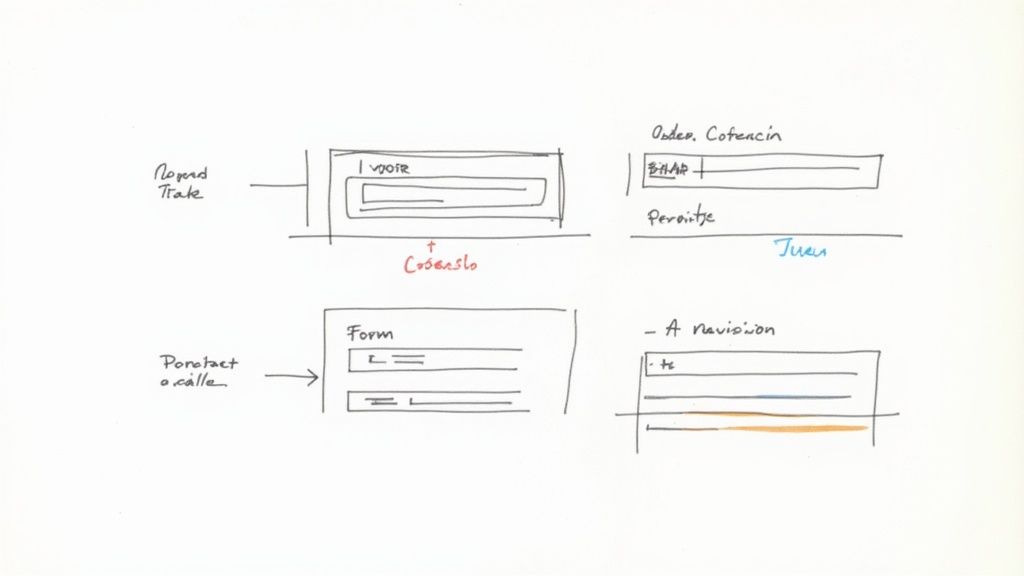Website Conversion Boost: Proven Strategies for Higher ROI
Understanding Your Current Conversion Landscape

To improve your website's conversion rate, you first need to take a close look at how your site is currently performing. Think of it like getting a health checkup - you need to know what's working well and what needs attention. By examining your conversion data carefully, you can make smart decisions about which changes will have the biggest impact.
Benchmarking and Industry Standards
How does your site stack up against others in your industry? Most websites convert around 2.35% of visitors, but the best performers can reach 11% or higher. Take the sporting goods industry as an example - while the average hovers around 2.35%, some standout sites do much better. This shows there's often plenty of room to grow. For instance, if you're hitting the industry average, that's a good start - but looking at top performers can show you what's truly possible. Looking at specific metrics like the 3.3% average for direct traffic helps you spot which traffic sources need work.
Analyzing Your Conversion Funnel
Your conversion funnel shows exactly how visitors move through your site - from first arriving to taking action like making a purchase. It's like following footprints in the sand to see where people go and where they turn back. For example, if lots of people add items to their cart but don't buy, that's a clear sign your checkout process needs work. By tracking key numbers at each step (page views, cart additions, purchases), you can find and fix the weak spots that are costing you sales.
The Role of Traffic Sources
Not all website traffic is created equal when it comes to conversions. Direct traffic - people typing your web address directly - tends to convert better than social media visitors. This makes sense: someone who comes straight to your site probably knows what they want, while someone clicking a social media ad might just be browsing. Paid search traffic, with its average 2.9% conversion rate, often falls somewhere in between. Understanding these patterns helps you focus your efforts where they'll pay off most. You might decide to create special landing pages for your paid ads while making your checkout process smoother for direct visitors.
Getting a clear picture of your current conversion landscape is like drawing a map before starting a journey - it shows you where you are and helps you plan the best route forward. By looking closely at your traffic sources, comparing yourself to industry standards, and finding problems in your conversion funnel, you can make smart choices about what to fix first. This careful analysis helps ensure that the time and money you invest in improvements will actually lead to better results.
Crafting Landing Pages That Actually Convert
A landing page is your conversion powerhouse - the place where visitors become customers. After examining your current conversion rates and results, you'll want to focus on building pages that speak directly to your audience's needs and motivate them to take action. One key element that can make a big difference is video content. Studies show that adding video to landing pages can boost conversions by up to 86%. Why? Because video helps explain complex ideas quickly and builds trust with potential customers in a way that text alone cannot.
Designing For Engagement and Conversion
The best landing pages make it easy and natural for visitors to take the next step. Here are the essential pieces to include:
- Clear and Concise Messaging: Get straight to the point about how you solve your visitor's problem. Skip the fancy industry terms and focus on real benefits.
- Compelling Visuals: Strong images and videos do more than just look nice - they help tell your story and keep visitors engaged. Think about how a mouth-watering food photo makes you want to try a recipe more than just reading the ingredients.
- Strategic Call-to-Actions (CTAs): Your CTA buttons need to stand out and use persuasive text. Simple changes like switching from "Submit" to "Get My Free Quote" can lead to many more clicks. Test different options to find what works best.
- Mobile Optimization: More people browse on phones than ever before, so your landing page must work perfectly on small screens. This means making text readable, buttons easy to tap, and layouts that flow well on mobile devices.
A/B Testing: Refining Your Approach
Think of A/B testing like running small experiments to improve your landing page piece by piece. You might test different layouts, try shorter or longer forms, or move testimonials around to see what gets better results. The key is to make data-backed decisions instead of just guessing what might work. By carefully tracking how each change affects your conversion rates, you can keep improving your pages over time.
Bridging the Mobile-Desktop Conversion Gap
While desktop users still convert more often, having a smooth mobile experience is essential. Look at how people use your site on phones versus computers and fix any issues that make mobile conversions harder. This could mean simplifying checkout steps, making forms easier to fill out with thumbs, or speeding up page load times. Small improvements to the mobile experience can lead to big gains in conversions. Just think about the last time you left a website because it was hard to use on your phone - fixing those frustrations keeps visitors around longer.
These elements work together to turn your landing pages into reliable sources of new customers and sales. Since landing pages often give visitors their first impression of your business, it's worth taking the time to get them right. Focus on what matters to your visitors, test different approaches, and keep refining based on real data.
Harnessing Social Proof to Drive Conversions

Once you've optimized your landing pages, it's time to focus on one of the most effective ways to increase website conversions - social proof. Think about your own buying habits. When considering a purchase, you probably check what other customers are saying first. This natural tendency to trust peer recommendations makes social proof an essential element for boosting conversions.
The Impact of Social Proof
First-time visitors need reassurance before making a purchase. Reviews, testimonials, and real customer experiences provide that confidence by showing that others have already had success with your product. For instance, websites that display customer photos and authentic user content see conversion increases of up to 161%. This makes sense - real customer stories connect much more deeply than standard marketing materials. Data from Yotpo confirms this, showing direct links between user-generated content and increased sales.
Getting More Authentic Social Proof
The key is creating simple ways for happy customers to share their experiences. Here are effective methods to gather genuine social proof:
- Customer Testimonials: Ask satisfied customers to describe specific ways your product helped them. Focus on real stories that potential buyers can relate to.
- User Reviews: Add review functionality directly on product pages. Make the review process quick and straightforward to encourage more submissions.
- User-Generated Content: Ask customers to share photos and videos using your products. Consider offering small rewards or running contests to increase participation.
- Social Media Proof: Feature positive mentions from social media on your site. This shows active engagement and builds trust through real-time feedback.
Keeping It Real Builds Trust
When it comes to social proof, authenticity matters most. Fake or overly promotional testimonials can hurt your credibility more than having no reviews at all. Welcome both positive feedback and constructive criticism - this transparency helps buyers make informed choices. Take time to respond thoughtfully to all reviews, even negative ones. This shows you genuinely care about customer satisfaction and are committed to addressing concerns. By maintaining this honest, customer-focused approach, you'll build trust naturally and see your conversion rates climb.
Building Personalized Customer Experiences

Creating meaningful connections with website visitors requires going beyond one-size-fits-all approaches. When you understand and respond to individual customer preferences, you can develop experiences that resonate on a personal level. This personal touch helps build stronger relationships that naturally lead to better engagement and more conversions.
The Power of Personalized CTAs
Call-to-action buttons work best when they speak directly to visitor interests. Instead of generic "Buy Now" buttons, consider what each visitor cares about based on their browsing patterns. For instance, someone exploring running shoes would likely respond better to "Find Your Perfect Fit" or "Shop Running Shoes Now." This simple shift to more relevant messaging makes a real difference - studies show personalized CTAs can boost click rates by up to 42% compared to generic ones. The data clearly shows that taking time to customize these key conversion points pays off.
Segmentation and Behavioral Targeting
Getting personalization right starts with smart audience grouping. By organizing visitors based on shared traits like demographics, past purchases, or browsing habits, you can craft messages that truly connect. New visitors might appreciate a welcome discount, while loyal customers often prefer exclusive perks or rewards program benefits. You can take this even further by tracking how people interact with your site - which pages they visit, how long they stay, and which products catch their eye. These insights help you adjust content and offers in real-time to match each visitor's interests.
Balancing Personalization and Privacy
While customer data enables better personalization, using it responsibly builds trust. Make your data collection practices clear and give visitors control over their experience with simple opt-in and opt-out choices. Following privacy regulations isn't just about compliance - it shows customers you value and protect their information. This honest approach helps create lasting relationships. When you blend smart personalization with strong privacy protection, everyone wins - you get better conversion rates while customers feel valued and respected. It's an approach that supports long-term business growth while putting customer needs first.
Optimizing Multi-Channel Conversion Pathways

Boosting website conversions requires looking at both individual touchpoints and how different marketing channels work together. Rather than focusing on single interactions, successful businesses create smooth customer journeys across multiple platforms. Take a typical path - a customer might first see your brand on Instagram, join your email list after visiting your website, then finally make a purchase through an email promotion. Each step builds on the previous one to guide visitors toward becoming customers.
Maximizing Paid Search Performance
With average conversion rates of 2.9%, Google Ads helps you reach people actively searching for what you offer. But running basic ads isn't enough to see real results. The key is matching your ads to exactly what searchers want. This means choosing specific keywords, writing ad copy that addresses their needs, and creating focused landing pages that deliver on your ad's promise. Keep testing different versions of your ads and landing pages to find what works best. Track the data, make improvements, and watch your conversion rates climb over time.
Leveraging Email Marketing's ROI
Email continues to deliver amazing results, returning $36-$40 for every dollar spent on average. This success comes from building relationships with subscribers over weeks and months. But you can't just blast the same message to everyone. Break your list into smaller groups based on what people buy, which emails they open, and how they interact with your brand. For example, welcome new subscribers with a special discount, while bringing back inactive customers with personalized product picks. When you send more relevant emails, people are more likely to open, click and buy.
Capitalizing on Social Media's Conversion Potential
Facebook, Instagram and other social platforms let you connect with potential customers in a more casual way. While social visitors may not buy right away, these channels help build awareness and loyalty over time. Focus on creating content your audience wants to share and engage with. Run targeted ads that send people to landing pages designed to convert. Show social proof like customer reviews and photos - it's like digital word-of-mouth that builds trust. When someone sees friends and other customers having positive experiences with your brand, they're more likely to buy too. By coordinating your message across channels while playing to each platform's strengths, you can create conversion paths that consistently turn visitors into customers.
Implementing Advanced Conversion Techniques
Effective website conversion optimization requires going deeper than surface-level changes. By implementing sophisticated strategies and tracking methods, you can better understand user behavior and identify key opportunities to improve results. Let's explore some proven advanced techniques that can help take your conversion rates to the next level.
Leveraging AI-Driven Optimization and Advanced Analytics
Modern analytics and optimization tools have made it possible to personalize user experiences at scale. For example, AI systems can automatically customize product recommendations, adjust website copy for different audience segments, and optimize email campaign timing based on user behavior patterns. It's like having a team of analysts constantly fine-tuning your site for each visitor. By combining these AI capabilities with in-depth analytics, you can spot valuable patterns and opportunities that basic tools might miss. This data-driven approach helps you make informed decisions about where to focus your optimization efforts.
Utilizing Heatmaps and Session Recordings
To improve conversions effectively, you need to understand exactly how visitors interact with your website. Hotjar and similar tools provide heatmaps that show where users click, scroll, and focus their attention. This visual data quickly reveals if visitors are trying to click non-clickable elements or missing important calls-to-action. Session recordings take this a step further by letting you watch actual user journeys through your site. By observing real visitors navigate your pages, you can spot confusing elements, identify where people get stuck, and fix roadblocks in your conversion process.
Building a Data-Driven Optimization Culture
Making the most of advanced conversion techniques requires shifting how your team approaches website improvements. Rather than relying on assumptions, create processes to regularly collect data, test changes, and measure results. Consider setting up a dedicated optimization team to coordinate testing efforts and share insights across departments. Think of it as creating a continuous improvement cycle - you gather data, implement changes based on that information, measure the impact, and use those results to guide your next optimization decisions. This systematic approach helps ensure your website keeps evolving to better serve your visitors' needs.
Ready to transform your website into a conversion powerhouse? Sitebot empowers you with custom AI chatbots tailored to your unique content and brand identity. Seamlessly integrate on your website and popular platforms to enhance customer engagement, personalize interactions, and drive business growth. Check out Sitebot today and discover the future of website conversions: https://sitebot.co


